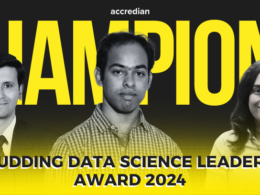This is a 2 part blog series that will provide you with a comprehensive data science roadmap that can aid your learning, helping you succeed in a world loaded with data. Make sure to stay tuned for part-2!
As of 2022, the average salary that a data scientist makes in the US is over $1,17,212 per annum. With that stated, it can be affirmed that data scientists are high in demand. You can think of data science as a way to earn money but then you will never have the actual motivation to learn it.
Instead, you should identify a problem; be it marketing-related or a research problem, and then start learning data science and its tools accordingly, because you cannot excel at every tool or a data science skill set.
First and foremost, you need to motivate yourself to love the data, with no drive you will probably leave your learning journey at some point. Furthermore, you need to work on real projects.
Just acquiring the fundamental skills won’t make you an expert, likewise, to increase your expertise, you need to increase the level of difficulty every time you undertake a data science project.
While being at work or at an internship, learn from your peers and subordinates, check how they are executing the data science projects. Last but not least, present your insights and analysis to others.
But you might be wondering what skills do you exactly require for being a successful data scientist and how to start? What steps do you need to follow to leap into the field of data science?
Step 1: Getting Started
Before you move on to learning and adapting to new skills, it is important for you to understand what data science is and whether you are a great fit for data science or not.
Plainly stated, data science involves extracting knowledge from data you gather using different methodologies. As a data scientist, you take a complex business problem, compile research from it, create it into data, then use that data to solve the problem.
What does this mean for you and how and where do you start?
All you need is a clear, deep understanding of a business’ domain and a lot of creativity which, undoubtedly, you have. For eg. a significant area of interest in data science concerns fraud, especially internet fraud. Here, data scientists create algorithms to detect fraud and prevent it by using their skills.
But to dive deep into the field of Data Science, check out our very well versed and comprehensive program called, PGP in Data Science & AI, that precisely explains what data science is, it further enlightens on the roles of data scientists, data engineers and data analysts that can surely help you in deciding which boat to jump in.
Step 2: Learn the basics of mathematics & statistics
The next checkpoint in the data science roadmap is to learn the fundamentals of mathematics and statistics. The topics listed below should be your area of focus:
- Descriptive Statistics
- Probability
- Inferential Statistics
- Linear Algebra
- Structured Thinking
This cheat sheet by MIT can help you build your concepts for statistics and likewise here is another cheat sheet by Harvard’s William Chen that can help you with understanding the basics of probability.
Step 3: Learning the Key Tools for Data Science
1. Python: It is one of the most popular and widely used programming languages. Learning this language can help you with creating web applications, handling big data, rapid prototyping and much more.
2. R: Another popular language for programming is R. It provides a free software environment for statistical computing.
You might be stuck with the same traditional argument between R vs Python; if you are wondering which one of them you should opt for, then we suggest you begin with R and transition to Python gradually. Then use them as per the needs of your organization.
3. Data Exploration and Visualization: If you are into the analytical side of the data i.e. data analysis then you must learn data exploration and visualization. Data exploration being the initial step of data analysis, while, data visualization is the graphical representation of data itself.
Both Python and R can be used for exploring and visualizing the data.
Now that you have a fair idea of the initial steps you need to follow, you are ready for part 2 of this blog series.






1 comment